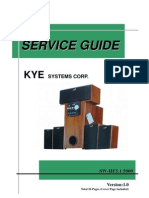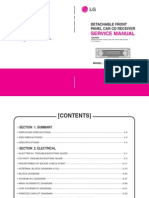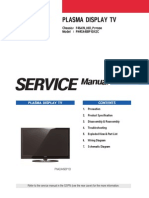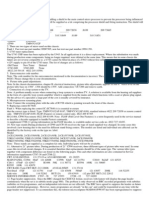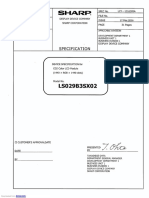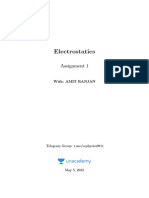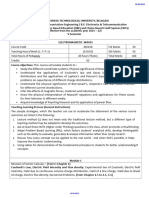0 ratings0% found this document useful (0 votes)
197 viewsDetachable Front Panel Car CD Receiver: Service Manual
Detachable Front Panel Car CD Receiver: Service Manual
Uploaded by
Mircea AlexThis document is a service manual for a detachable front panel car CD receiver model LAC-M1600R. It contains safety precautions and specifications for servicing the unit. The electrical troubleshooting guide provides steps to diagnose issues such as no power, abnormal LCD light, and initial reading not occurring. It includes checking voltages, waveforms and components like the power supply, microcontroller, and CD circuitry. Exploded views show the cabinet assembly and mechanism components.
Copyright:
© All Rights Reserved
Available Formats
Download as PDF, TXT or read online from Scribd
Detachable Front Panel Car CD Receiver: Service Manual
Detachable Front Panel Car CD Receiver: Service Manual
Uploaded by
Mircea Alex0 ratings0% found this document useful (0 votes)
197 views31 pagesThis document is a service manual for a detachable front panel car CD receiver model LAC-M1600R. It contains safety precautions and specifications for servicing the unit. The electrical troubleshooting guide provides steps to diagnose issues such as no power, abnormal LCD light, and initial reading not occurring. It includes checking voltages, waveforms and components like the power supply, microcontroller, and CD circuitry. Exploded views show the cabinet assembly and mechanism components.
Original Description:
LG service car audio
Original Title
Lg Lac m1600
Copyright
© © All Rights Reserved
Available Formats
PDF, TXT or read online from Scribd
Share this document
Did you find this document useful?
Is this content inappropriate?
This document is a service manual for a detachable front panel car CD receiver model LAC-M1600R. It contains safety precautions and specifications for servicing the unit. The electrical troubleshooting guide provides steps to diagnose issues such as no power, abnormal LCD light, and initial reading not occurring. It includes checking voltages, waveforms and components like the power supply, microcontroller, and CD circuitry. Exploded views show the cabinet assembly and mechanism components.
Copyright:
© All Rights Reserved
Available Formats
Download as PDF, TXT or read online from Scribd
Download as pdf or txt
0 ratings0% found this document useful (0 votes)
197 views31 pagesDetachable Front Panel Car CD Receiver: Service Manual
Detachable Front Panel Car CD Receiver: Service Manual
Uploaded by
Mircea AlexThis document is a service manual for a detachable front panel car CD receiver model LAC-M1600R. It contains safety precautions and specifications for servicing the unit. The electrical troubleshooting guide provides steps to diagnose issues such as no power, abnormal LCD light, and initial reading not occurring. It includes checking voltages, waveforms and components like the power supply, microcontroller, and CD circuitry. Exploded views show the cabinet assembly and mechanism components.
Copyright:
© All Rights Reserved
Available Formats
Download as PDF, TXT or read online from Scribd
Download as pdf or txt
You are on page 1of 31
DETACHABLE FRONT
PANEL CAR CD RECEIVER
SERVICE MANUAL
CAUTION
BEFORE SERVICING THE UNIT, READ THE SAFETY PRECAUTIONS
IN THIS MANUAL.
MODEL:LAC-M1600R
S
E
R
V
IC
E
M
A
N
U
A
L
M
O
D
E
L
:
L
A
C
-
M
1
6
0
0
R
- 1-1 -
[CONTENTS]
SECTION 1.GENERAL
SERVICING PRECAUTIONS . . . . . . . . . . . . . . . . . . . . . . . . . . . . . . . . . . . . . . . . . . . . . . . 1-2
ESD PRECAUTIONS . . . . . . . . . . . . . . . . . . . . . . . . . . . . . . . . . . . . . . . . . . . . . . . . . . . . . 1-3
SPECIFICATIONS . . . . . . . . . . . . . . . . . . . . . . . . . . . . . . . . . . . . . . . . . . . . . . . . . . . . . . . .1-4
SECTION 2. ELECTRICAL
ELECTRICAL TROUBLESHOOTING GUIDE . . . . . . . . . . . . . . . . . . . . . . . . . . . . . . . . . . . . 2-1
WAVEFORMS OF MAJOR CHECK POINT . . . . . . . . . . . . . . . . . . . . . . . . . . . . . . . . . . . . . 2-6
INTERNAL BLOCK DIAGRAM of ICs . . . . . . . . . . . . . . . . . . . . . . . . . . . . . . . . . . . . . . . . . 2-7
BLOCK DIAGRAM . . . . . . . . . . . . . . . . . . . . . . . . . . . . . . . . . . . . . . . . . . . . . . . . . . . . . . . 2-17
SCHEMATIC DIAGRAMS . . . . . . . . . . . . . . . . . . . . . . . . . . . . . . . . . . . . . . . . . . . . . . . . . 2-19
PRINTED CIRCUIT DIARGAMS . . . . . . . . . . . . . . . . . . . . . . . . . . . . . . . . . . . . . . . . . . . . 2-27
SECTION 3. EXPLODED VIEWS
CABINET AND MAIN FRAME SECTION . . . . . . . . . . . . . . . . . . . . . . . . . . . . . . . . . . . . . . . 3-1
MECHANISM (PICK-UP) . . . . . . . . . . . . . . . . . . . . . . . . . . . . . . . . . . . . . . . . . . . . . . . . . . . 3-3
SECTION 4. REPLACEMENT PARTS LIST . . . . . . . . . . . . . . . . . . . . . . . . . . .4-1
- 1-2 -
SECTION 1. SUMMARY
SERVICING PRECAUTIONS
Always disconnect the power source before:
1) Removing or reinstalling any component, circuit board, module or any other instrument assembly.
2) Disconnecting or reconnecting any instrument electrical plug or other electrical connection.
3) Connecting a test substitute in parallel with an electrolytic capacitor in the instrument.
CAUTION: A wrong part substitution or incorrect polarity installation of electrolytic capacitors may result in
an explosion hazard.
Do not defeat any plug/socket B+ voltage interlocks with which instruments covered by
this service manual might be equipped.
Do not apply power to this instrument and or any of its electrical assemblies unless all
solid-state device heat sinks are correctly installed.
Always connect a test instruments ground lead to the instrument chassis ground before
connecting the test instrument positive lead. Always remove the test instrument ground
lead last.
1) The service precautions are indicated or printed on the cabinet, chassis or components. When servicing,
follow the printed or indicated service precautions and service materials.
2) The Components used in the unit have a specified conflammability and dielectric strength. When replac-
ing any components, use components which have the same ratings. Components marked in the cir-
cuit diagram are important for safety or for the characteristics of the unit. Always replace with the exact
components.
3) An insulation tube or tape is sometimes used and some components are raised above the printed writing
board for safety. The internal wiring is sometimes clamped to prevent contact with heating components.
Install them as they were.
4) After servicing always check that the removed screws, components and wiring have been installed cor-
rectly and that the portion around the service part has not been damaged. Further check the insulation
between the blades of attachment plug and accessible conductive parts.
- 1-3 -
ESD PRECAUTIONS
Electrostatically Sensitive Devices (ESD)
Some semiconductor (solid state) devices can be damaged easily by static electricity. Such components
commonly are called Electrostatically Sensitive Devices (ESD). Examples of typical ESD devices are integrated
circuits and some field-effect transistors and semiconductor chip components. The following techniques should
be used to help reduce the incidence of component damage caused by static electricity.
1. Immediately before handling any semiconductor component or semiconductor-equipped assembly, drain off
any electrostatic charge on your body by touching a known earth ground. Alternatively, obtain and wear a
commercially available discharging wrist strap device, which should be removed for potential shock reasons
prior to applying power to the unit under test.
2. After removing an electrical assembly equipped with ESD devices, place the assembly on a conductive sur-
face such as aluminum foil, to prevent electrostatic charge buildup or exposure of the assembly.
3. Use only a grounded-tip soldering iron to solder or unsolder ESD devices.
4. Use only an anti-static solder removal device. Some solder removal devices not classified as "anti-static" can
generate electrical charges sufficient to damage ESD devices.
5. Do not use freon-propelled chemicals. These can generate electrical charges sufficient to damage ESD
devices.
6. Do not remove a replacement ESD device from its protective package until immediately before you are
ready to install it. (Most replacement ESD devices are packaged with leads electrically shorted together by
conductive foam, aluminum foil or comparable conductive materials).
7. Immediately before removing the protective material from the leads of a replacement ESD device, touch the
protective material to the chassis or circuit assembly into which the device will by installed.
CAUTION : BE SURE NO POWER IS APPLIED TO THE CHASSIS OR CIRCUIT, AND OBSERVE ALL
OTHER SAFETY PRECAUTIONS.
8. Minimize bodily motions when handing unpackaged replacement ESD devices. (Otherwise harmless motion
such as the brushing together of your clothes fabric or the lifting of your foot from a carpeted floor can gen-
erate static electricity sufficient to damage an ESD device).
CAUTION. GRAPHIC SYMBOLS
THE LIGHTNING FLASH WITH APROWHEAD SYMBOL. WITHIN AN EQUILATERAL TRIANGLE,
IS INTENDED TO ALERT THE SERVICE PERSONNEL TO THE PRESENCE OF UNINSULATED
DANGEROUS VOLTAGE THAT MAY BE OF SUFFICIENT MAGNITUDE TO CONSTITUTE A
RISK OF ELECTRIC SHOCK.
THE EXCLAMATION POINT WITHIN AN EQUILATERAL TRIANGLE IS INTENDED TO ALERT
THE SERVICE PERSONNEL TO THE PRESENCE OF IMPORTANT SAFETY INFORMATION IN
SERVICE LITERATURE.
- 1-4 -
SPECIFICATIONS
1. GENERAL
Power requirements . . . . . . . . . . . . . . . . . . . . . . . . . . . . . . . . . . . . . . . . . . . . . . . . . . DC12V~15V
Ground system . . . . . . . . . . . . . . . . . . . . . . . . . . . . . . . . . . . . . . . . . . . . . . . . . . . . . . . . . Negative
Dimensions(W x H x D) . . . . . . . . . . . . . . . . . . . . . . . . . . . . . . . . . . . . . . . . . . . 188 x 58 x 166mm
Weight . . . . . . . . . . . . . . . . . . . . . . . . . . . . . . . . . . . . . . . . . . . . . . . . . . . . . . . . . . . . . . Net: 1.3kg
2. RADIO SECTION
FM AM(MW)
Frequency range 65.0~74.0MHz(Optional), 522~1,620kHz
87.5~108MHz (Optional:530~1,710kHz/ 520~1,620kHz)
Intermediate frequency 10.8MHz 450kHz
Usable sensitivity 10dBV 28dBV
Signal to noise ratio 55dB 45dB
3. COMPACT DISC SECTION
Frequency response . . . . . . . . . . . . . . . . . . . . . . . . . . . . . . . . . . . . . . . . . . . . . . . . . . 40Hz~20kHz
Channel separation (Line out) . . . . . . . . . . . . . . . . . . . . . . . . . . . . . . . . . . . . . . . . . . . 90dB (1kHz)
Signal to noise ratio (Line out) . . . . . . . . . . . . . . . . . . . . . . . . . . . . . . . . . . . . . . . . . . . . . . . 110dB
4. AUDIO SECTION
Maximum output power . . . . . . . . . . . . . . . . . . . . . . . . . . . . . . . . . . . . . . . . . . . . . . . . . . . 50W x 4
Speaker impedance . . . . . . . . . . . . . . . . . . . . . . . . . . . . . . . . . . . . . . . . . . . . . . . 4 x 4 or 8 x 4
NOTE: The design and specifications are subject to change without notice in the sourse of product
improvement.
- 2-1 -
SECTION 2. ELECTRICAL
ELECTRICAL TROUBLESHOOTING GUIDE
1. No Power.
Any Key power on.
YES
YES
YES
YES
YES
YES
NO
NO
NO
NO
NO
Is power turnd on?
DISC loading?
Does initial reading occur?
Can disc be played?
Is audio output supplied?
OK
Check audio circuitry.
IC501,IC509, CN503
Check tracking servo circuitry.
Q541, IC501, IC503
Check DISC.
Check focusing circuitry.
Q541, IC501
Check laser circuitry.
Q541, IC501
Check loading supply circuitry.
Q9001, Q902, Q903, Q904, PN503,
IC507, IC506, IC508
Check power supply circuitry.
Q930, Q924, Q919,
Q920, Q921, IC902, pin1
- 2-2 -
2. LCD light abnornal.
YES
YES
YES
YES
YES
YES
NO NO
NO
NO
NO
NO
NO
Any Key power on.
(without DISC)
Do display LCD then light?
Check voltage in the power
supply
Power supply circuitry defective.
Q371,Q372,IC403
Reset circuit defective.
IC901 Surrounding circuit
defective.
X101,X102,C101,
C102,C103,C104.
Q921,ZD910
PCB pattern defective.
IC906,Pin74,75,76
front PCB pattern defective.
IC901,Surrounding circuit
PCB pattern defective.
Display LCD
connector defective.
Is IC901 Com1, Com2, Com3
output waveform normal?
Is u-com IC401 Pin75, 76, 78
output waveform normal?
Is u-com IC906 LCD reset
circuit normal?Pin74
Is u-com IC906 keyin
Pin19,20 5volt input?
Is u-com IC906 X1,X2 terminal
Pin11,12,14,15 input?
OSC :19.2MHz
OSC :32.768kHz
- 2-3 -
3. Initial reading is not carried out.
YES
YES
YES
YES
YES
YES
YES
YES
YES
YES
YES
YES
YES (with disc)
NO NO
NO
NO
NO
NO
NO
NO
NO
NO
NO
Slide motor moves
(With disc)
Spindle motor turns
WAVEFORM #1
Does RF waveform
appear? IC501 Pin49
WAVEFORM #2
Check the Voltage change of
CN503 Pin12 (6.4~6.8V)
Check the Voltage IC501
Pin23 (1.4V~1.8V)
Check the Data transmission
from CN503 (16, 17, 18) to CD
DSP WAVEFORM #5
Check the Data transmission
from CN503 Pin21 to MICOM
WAVEFORM #5
Check the TRVP
Voltage
IC501 Pin23
Check the change of
SL +, SL - Voltage
IC503 Pin13,14
Does FA+ waveform appear at
IC501 Pin23?
WAVEFORM #3
Laser light check A ?
focus coil drive wareform.
TRACKING ERROR wareform
Defective contact CN501
Defective PICK-UP
Defective IC503
Defective IC501
Defective
connector CN503
Defective IC503
Defective connector
CN503 Defective
MICOM
Defective IC501
Defective
connector CN503
Does TE waveform appear at
IC501 Pin24?
WAVEFORM #4
Defective IC501
Defective PICK-UP
Is rotation normal?
Is there no dropout of RF signal?
- 2-4 -
When laser does not light. A
Is 2.4V~3.4V applied to
pin42 of IC501?
( 3.4V 2.4V)
Did pickup return to
innermost circular?
Does it stop at inner pick
circular after shift?
Is defect output from LMT
SW applied to Pin7 of
PN503?
Is data transferred from
MICOM IC ?
Does voltage appear at
IC503 Pin 13, 14?
Defective MICOM or CN503.
Defective IC501.
Defective slide motor and/or
connector. (CN502)
Defective LMT SW and/or
connector. (CN502,CN503)
Defective MICOM.
Defective IC501
Is power supplied to laser Q541?
(Q541 collector: about 1.8V)
OV
YES
YES
YES
YES
YES
YES
NO
NO
NO
NO
NO
NO
OPEN CLOSE
- 2-5 -
When laser light. B
When SPINDLE motor dose not turn C
NO
NO
NO
NO
YES
YES
YES
YES
Laser lights
Check the signal FOCUS
SEARCH of IC501 Pin25
WAVEFORM #3
Check the signal of IC503
Pin 15, 16
WAVEFORM #3
Defective IC501
Defective IC501
Degraded laser diode
Defective PICK-UP
Defective IC501
Defective IC503
Defective contact CN501
or Defective PICK-UP
Check the change for
SP +, SP -, Voltage of
IC503 Pin11, 12
WAVEFORM #1
Check the change for
SPDO Voltage of
IC501 Pin21
WAVEFORM #1
- 2-6 -
WAVEFORMS OF MAJOR CHECK POINT
#1. SPINDLE DRIVE AND MOTOR WAVEFORM
IC501(21), IC504(12) during TOC reading
#2. RF WAVEFORM
IC501(45), IC501(49) during TOC reading
#3. FOCUS DRIVE AND MOTOR WAVEFORM
IC501(25), IC503(15)
When focus search failed or there is no disc on tray
#4. TRACK DRIVE AND MOTOR WAVEFORM
IC504(24), IC503(17) during TOC reading
There is disc on tray and focus search success
- 2-7 -
INTERNAL BLOCK DIAGRAM of ICs
I AV_CAR
1) Micom Port Assignment
- 2-8 -
2) Pin Descriptions
- 2-9 -
- 2-10 -
I BD3805F
1) BLOCK DIAGRAM
- 2-11 -
I MN6627933CN(DSP)
1) Connection Diagram
- 2-12 -
I TA8275HQ
1) Block Diagram
- 2-13 -
I upd78f0546(Micom)
1) Block Diagram
- 2-14 -
2) Pin lay out
- 2-15 -
3) Pin Function
PIN NAME Function
VDD Positive power supply except for ports ( except P20-P27 and P121-P124) and AD converter
VSS Ground potential except for ports (except P20-P27 and P121-P124) and AD converter
EVDD Positive power supply for ports (expect p20-p27 and p121-p124)
EVSS Ground potential for ports (except p20-p27 and p121-p124)
RESET System reset input
FLMDO Flash EEPROM programming mode setting
REGC Connecting regulator stabillzation capacitor. Connect to GND via a capacitor (0.47F).
AVREF A/D converter analog power supply and power supply for p20-p27
AVSS Ground potential for A/D convert and p20-p27
P00/T1000 I/O port
External count clock input to 16-bit timer/event counter 00
Capture trigger input to capture reglsters (CR000, CR010) of 16-bit timer/event counter 00(TM00)
P01/TI010/TO00 I/O port
Capture trigger input to capture register (CR000) of 16-bit timer/event counter 00 (TM00)
16-bit timer/event counter 00 outout (TM00)
P02/SO11 I/O port
Serial data output from serial interface (CSI11)
PO3/SI11 I/O port
Serial data input to serial interface (CSI11)
P20/SCK11 I/O port
Clock input/output for serial interface (CSI11)
P05/TI001/SSI11 I/O port
External count clock input to 18-bit timer/event counter 01
Capture trigger input to capture reglsters (CR001, CR011) of 16-bit timer/event counter 01( TM01)
Chip input/output for serial interface (CSI11)
P06/TI011/TO01 I/O port
Capture trigger input to capture register (CR001) of 160bit timer/evrnt counter 01 (TM01)
16-bit timer/evrnt counter 01 output (TM01)
P10/SCK10/TXD0 I/O port
Clock input/output for serial interface (CSI10)
Serial data output from asynchronous serial interface (UART0)
P11/SI10/RXD0 I/O port
Serial data input to serial interface (CSI10)
Serial data input to asynchronous serial interface (UART0)
P12/SO10 I/O port
Serial data input to serial interface (CSI10)
P13/TXD6 I/O port
Serial data output from asynchronous serial interface (UART6)
P14.RXD6 I/O port
Serial data input to asynchronous serial interface (UART6)
P15/TOH0 I/O port
8-bit timer H0 output (TMH0)
P16/TOH1/NTP5 I/O port
8-bit timer H1 output (TMH1)
External interrupt request input with specifiable valia edges
P17/TI50/TO50 I/O port
External count clock input to 8-bit timer/event counter 50 (TM50)
8-bit timer/event counter 50 output (TM50)
P20-P27/ANI0-ANI7 I/O ports
A/D converter analog input
P30/INTP1 I/O port
P31/INTP2 External interrupt request input with specifiable vaild edges
P31/INTP2
P33 I/O port
/TI51 External count clock input to 8-bit time/event counter 51 (TM51)
/TO51 8-bit timer/event counter 51 output (TM51)
/INTP4 External interrupt request input with specifiable valid edges
P40-P47 I/O port
P50-P57 I/O port
P60/SCL0 I/O port (N-ch open drain)
Clock input/output for serial interface (IIC0)
P61/SDA0 I/O port (N-ch open drain)
Serial data input/output for serial interface (IIC0)
- 2-16 -
PIN NAME Function
P62/EXSCL0 I/O port (N-ch open drain)
External clock input for serial interface (IIC0)
P63 I/O port (N-ch open drain)
P64-P67 I/O ports
P70-P77 I/O ports
/KR0-KR7 Key interrupt input
P120 I/O port
/INTP0 External interrupt request input with specifiable vaild edges
/EXLVI Reference voltsge input for low voltage indicator
P121 I/O port (An external oscillation circuit is not used)
/X1 Connecting resonator for main system clock oscillation
P122 I/O port (An external oscillation circuit is not used)
/X2 Connecting resonator for main system clock oscillation
/EXCLK External clock input for main system clock
P123 I/O port (An external oscillation circuit is not used)
XT1 connecting resonator for subsystem clock oscillation
P123 I/O port (An external oscillation circuit is not used)
XT1 Connecting resonator for subsystem clock oscillation
P124 I/O port (An external oscillation circuit is not used)
/XT2 Connecting resonator for subsystem clock oscillation
/EXCLKS External clock input for subsystem clock
P130 Output port
P140 I/O port
/PCL Clock output
/INTP6 External interrupt request input with specifiable vaild edge
P141 I/O port
/PCL Clock output
/INTP7 External interrupt requwst input with specifiable vaild edge
/BUSY0 Busy signal input for serial interface (AUTOCSI)
P142 I/O port
/SCKA0 Clock input/output for serial interface (AUTOCSI)
P143 I/O port
/SIA0 Serial data input to serial interface
P144 I/O port
/SOA0 Serial data output from serial interface (AUTOCSI)
P145 I/O port
/STB0 Strobe signal input to serial interface (AUTOCSI)
BLOCK DIAGRAM
2-17 2-18
2-19 2-20
SCHEMATIC DIAGRAMS
MAIN SCHEMATIC DIAGRAM
2-21 2-22
MAIN-2 SCHEMATIC DIAGRAM
2-23 2-24
FRONT SCHEMATIC DIAGRAM
2-25 2-26
CD SCHEMATIC DIAGRAM
2-27 2-28
PRINTED CIRCUIT BOARD DIAGRAMS
MAIN P.C. BOARD DIAGRAM
2-29 2-30
FRONT/TRIM P.C. BOARD DIAGRAM LED P.C. BOARD
2-31 2-32
CD P.C. BOARD
3-1 3-2
452
283
450
250
451
453
452
452
452
A40
259
258
280
454
281
282
257
452
A41
A26
260
455
A43
261
454
262
264
269
268
263
265
267
266
272
273
274
271
270
291
A50
A42
A46
452
290
251
252
253
254
255
256
457
A49
835
818
*Accessory
SECTION 3. EXPLODED VIEWS
CABINET AND MAIN FRAME SECTION
3-3 3-4
2
3
4
5
1
1
2
A03
MECHANISM (PICK-UP)
LOCA. NO. PART NO. DESCRIPTION SPECIFICATION REMARKS
A03 6716CPD002A PICK UP,CD OPIMA-7261A1 JVC PLAYER FOR CDC-03LSV1
You might also like
- Samsung+WW70J4263 Manual de ServiçoDocument48 pagesSamsung+WW70J4263 Manual de ServiçoTiago Coitinho100% (2)
- CAN and FPGA Communication Engineering: Implementation of a CAN Bus based Measurement System on an FPGA Development KitFrom EverandCAN and FPGA Communication Engineering: Implementation of a CAN Bus based Measurement System on an FPGA Development KitNo ratings yet
- Genius SW-HF 5.1 5000.rarDocument26 pagesGenius SW-HF 5.1 5000.rarzzorox100% (3)
- Problems and Solutions On Electricity and MagnetismDocument15 pagesProblems and Solutions On Electricity and MagnetismMuhammad Ashfaq Ahmed50% (4)
- Tag MC LarenDocument34 pagesTag MC LarenelekossNo ratings yet
- DOE 01 Basic Electrical TheoryDocument61 pagesDOE 01 Basic Electrical Theorynidhiaithal11_770999100% (1)
- LG Mcv903 AouDocument83 pagesLG Mcv903 AouJose Vanderhorst Henriquez100% (1)
- 3Cd Changer DVD Karaoke System: Service ManualDocument56 pages3Cd Changer DVD Karaoke System: Service Manualluis262100% (2)
- Wd856-106uhsagd-Pe Manual ServicioDocument57 pagesWd856-106uhsagd-Pe Manual ServicioCesar Calderon Gr100% (2)
- Abc of Power Modules: Functionality, Structure and Handling of a Power ModuleFrom EverandAbc of Power Modules: Functionality, Structure and Handling of a Power ModuleNo ratings yet
- Detachable Front Panel Car CD Receiver: Service ManualDocument31 pagesDetachable Front Panel Car CD Receiver: Service ManualBorcan Cristi100% (2)
- Lac-M3600 M3600RDocument31 pagesLac-M3600 M3600RДмитрийNo ratings yet
- Lac M7600Document39 pagesLac M7600RenatoMaiaNo ratings yet
- Service Manual: Detachable Front Panel Car CD ReceiverDocument35 pagesService Manual: Detachable Front Panel Car CD ReceiverLuca ANo ratings yet
- Lac M5500Document32 pagesLac M5500RenatoMaiaNo ratings yet
- LM-D2360 D2560aDocument66 pagesLM-D2360 D2560aanon_30516784No ratings yet
- LPX M930aDocument39 pagesLPX M930aJhonatan CastroNo ratings yet
- LG LH T7654iaDocument67 pagesLG LH T7654iaDoicho Andonov100% (1)
- Lg-Lm-K3960a LG-LMS-K3960VDocument65 pagesLg-Lm-K3960a LG-LMS-K3960VDaniel GómezNo ratings yet
- LH T7652SBDocument67 pagesLH T7652SBSerp1972No ratings yet
- Lac M2500Document31 pagesLac M2500RenatoMaiaNo ratings yet
- Lac m8410 GCSCDocument52 pagesLac m8410 GCSCRenatoMaiaNo ratings yet
- Mini Hi-Fi System: Service ManualDocument83 pagesMini Hi-Fi System: Service ManualAnonymous Lfgk6vygNo ratings yet
- TCH M900Document36 pagesTCH M900ДмитрийNo ratings yet
- Service Manual: Detachable Front Panel Car CD ReceiverDocument39 pagesService Manual: Detachable Front Panel Car CD ReceiverJulian CamposNo ratings yet
- DVD/CD Receiver: Service ManualDocument57 pagesDVD/CD Receiver: Service ManualAlfredo Valencia RodriguezNo ratings yet
- LG Ht302sdDocument57 pagesLG Ht302sdsel_morNo ratings yet
- LG Ht924sfDocument87 pagesLG Ht924sfSerp1972100% (2)
- Lm-k3960 Manual de ServicioDocument65 pagesLm-k3960 Manual de Servicioluisrey1967No ratings yet
- LG LH w750!1!2 3ta Lhs w75 Tac Taf Tal Tar Taw Acc75t SMDocument66 pagesLG LH w750!1!2 3ta Lhs w75 Tac Taf Tal Tar Taw Acc75t SMrick_hunter02000No ratings yet
- Magnavox CMWR10D6 Service ManualDocument55 pagesMagnavox CMWR10D6 Service ManualcaimanaterNo ratings yet
- Samsung Pn42a450p1d Chassis F45a PDFDocument72 pagesSamsung Pn42a450p1d Chassis F45a PDFDa ElNo ratings yet
- LG Lx-U250a Lxs-U250Document55 pagesLG Lx-U250a Lxs-U250remanuel18No ratings yet
- LH T6540Document54 pagesLH T6540raja1701No ratings yet
- 50HDW2Document90 pages50HDW2Zoltán UreczkiNo ratings yet
- LG HT964TZ PDFDocument71 pagesLG HT964TZ PDFboroda2410100% (1)
- Samsung PS50Q - PlasmaDocument80 pagesSamsung PS50Q - Plasmaeraser2410No ratings yet
- LG Ht355sd Sh35sd SMDocument61 pagesLG Ht355sd Sh35sd SMZxdIaminxXzlovewithzxXzyouzx67% (3)
- Service Manual - 29 Slim TVDocument50 pagesService Manual - 29 Slim TVparascoliNo ratings yet
- Lavadora WD10M44 WD11M44 10kgDocument52 pagesLavadora WD10M44 WD11M44 10kgCristiano Pereira Do NascimentoNo ratings yet
- DVP 2003 Service ManualDocument48 pagesDVP 2003 Service ManualGeorge J. PitsakisNo ratings yet
- LG Ht303su Ht353sd SM (ET)Document81 pagesLG Ht303su Ht353sd SM (ET)domi56No ratings yet
- LC-20DV20U: LCD Color Television/ DVD Video PlayerDocument106 pagesLC-20DV20U: LCD Color Television/ DVD Video Playerhfog2000181No ratings yet
- HPT5054 Service ManualDocument90 pagesHPT5054 Service Manualmap0561No ratings yet
- Service: Washing Machine Top-Loading TypeDocument37 pagesService: Washing Machine Top-Loading TypeElifio MNo ratings yet
- LG Rad225b Ras225Document45 pagesLG Rad225b Ras225Richardson AlmeidaNo ratings yet
- LG Lmu360, Lmu365 Mini-Hifi Service ManualDocument65 pagesLG Lmu360, Lmu365 Mini-Hifi Service Manualcelltrix100% (1)
- Chassis KS9C-N-MI Manual de Servicio PDFDocument73 pagesChassis KS9C-N-MI Manual de Servicio PDFCristian ChavezNo ratings yet
- LG-LM-M1040 HiFi Schematic DiagramsDocument56 pagesLG-LM-M1040 HiFi Schematic DiagramsgeofreygachieNo ratings yet
- 3Cd Changer Mini Hi-Fi System: Service ManualDocument65 pages3Cd Changer Mini Hi-Fi System: Service ManualValdir KoxinhaprNo ratings yet
- Samsung Hlr4266w Hlr5067wx Xaa Chassis l64cDocument129 pagesSamsung Hlr4266w Hlr5067wx Xaa Chassis l64clondon335No ratings yet
- DC/DC Converter Handbook: SMPS topologies from an EMC point of viewFrom EverandDC/DC Converter Handbook: SMPS topologies from an EMC point of viewNo ratings yet
- Powerboater's Guide to Electrical Systems, Second EditionFrom EverandPowerboater's Guide to Electrical Systems, Second EditionRating: 5 out of 5 stars5/5 (1)
- Service Tips Chassis Cp90 110Document8 pagesService Tips Chassis Cp90 110Mircea AlexNo ratings yet
- MB Manual Ga-H61m-S2pv eDocument40 pagesMB Manual Ga-H61m-S2pv eMircea AlexNo ratings yet
- Sem 2005Document6 pagesSem 2005Mircea AlexNo ratings yet
- TI Syncronous Buck Converter ApplicationDocument40 pagesTI Syncronous Buck Converter ApplicationMircea AlexNo ratings yet
- LG FB-D162X FBS162V Sistema Audio CD-DVD Manual de ServicioDocument73 pagesLG FB-D162X FBS162V Sistema Audio CD-DVD Manual de Serviciohectormv220% (1)
- 853 Manual Rev1 9-10Document12 pages853 Manual Rev1 9-10Victor PintadoNo ratings yet
- ElectrostaticsDocument9 pagesElectrostaticstechzonesNo ratings yet
- Contact and Noncontact Forces StationDocument12 pagesContact and Noncontact Forces StationDemanda GookinNo ratings yet
- LG Home TheaterDocument121 pagesLG Home TheaterhermieNo ratings yet
- 32lg30ra TaDocument24 pages32lg30ra TaMikaela MaçkoNo ratings yet
- Electric Charges and FieldsDocument13 pagesElectric Charges and FieldsPriyanshu Kumar100% (2)
- Questions On Unit I (Basics of Electromagnetics)Document2 pagesQuestions On Unit I (Basics of Electromagnetics)Thota Venkata Lakshmi Manasa 22120487101No ratings yet
- 1PH813 BeDocument124 pages1PH813 BeRMK BrothersNo ratings yet
- SHARP 29inchDocument33 pagesSHARP 29inchBurak CNo ratings yet
- LG Rad225b Ras225Document45 pagesLG Rad225b Ras225Richardson AlmeidaNo ratings yet
- Flue Gas Cleaning: We Make The World A Cleaner PlaceDocument32 pagesFlue Gas Cleaning: We Make The World A Cleaner PlaceTC Capulcu Mustafa MNo ratings yet
- Electrostatics: Assignment 1Document83 pagesElectrostatics: Assignment 1Jitender MeenaNo ratings yet
- Pavli TaDocument7 pagesPavli TaCiro Giordano100% (2)
- Haier Let19c430 Chassis Msd306Document57 pagesHaier Let19c430 Chassis Msd306Luděk CharousNo ratings yet
- LG cm9960Document79 pagesLG cm9960GustavoNo ratings yet
- EMW Previous VTU PapersDocument19 pagesEMW Previous VTU Papersdevendiran.ecNo ratings yet
- 7580654-Lg Rc288 VCR DVD Recorder Service ManualDocument161 pages7580654-Lg Rc288 VCR DVD Recorder Service ManualHarvey Benson0% (1)
- AQA Uniform Electric Fields QPDocument19 pagesAQA Uniform Electric Fields QPjingcong liuNo ratings yet
- Lesson 1: Basic Terminology and ConceptsDocument160 pagesLesson 1: Basic Terminology and Conceptsdiala alazraiNo ratings yet
- ESD Asociation Standard For Protection of Electrostatic Disharge ANSI-ESD S6.1-1999Document14 pagesESD Asociation Standard For Protection of Electrostatic Disharge ANSI-ESD S6.1-1999EmilianoNo ratings yet
- Tesla Gravity PDFDocument7 pagesTesla Gravity PDFDev MckNo ratings yet
- PTZTE255.6B: EOS PowerDocument10 pagesPTZTE255.6B: EOS PowerPușcă MartinNo ratings yet
- EGCP 2 Installation and Operation Manual en TechManDocument234 pagesEGCP 2 Installation and Operation Manual en TechManRigoberto Lozano100% (2)
- Electromagnetic Field TheoryDocument32 pagesElectromagnetic Field TheoryDeepanwita SarNo ratings yet
- Nature of ElectricityDocument11 pagesNature of ElectricityJohn Christian HensonNo ratings yet
- Formulae Book of Physics Class XII 3Document102 pagesFormulae Book of Physics Class XII 3RRoptional instituteNo ratings yet
- JNTUH MSC Entrance Exam SyllabusDocument19 pagesJNTUH MSC Entrance Exam SyllabusAnweshaBoseNo ratings yet


